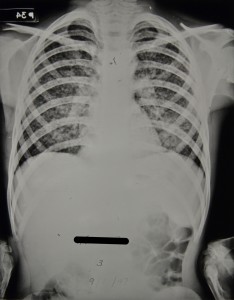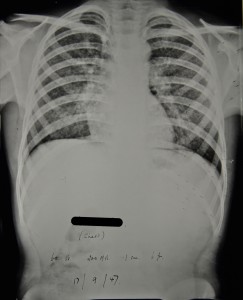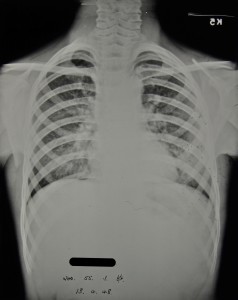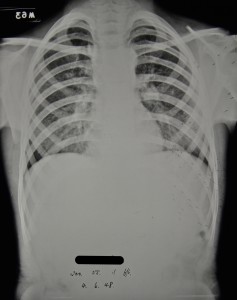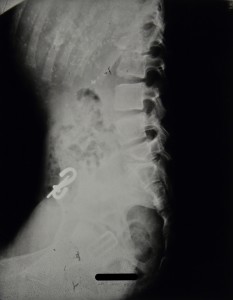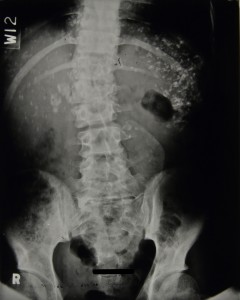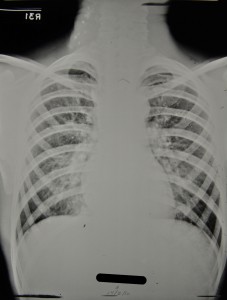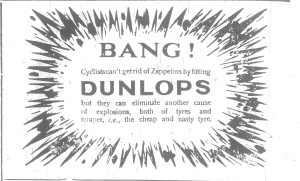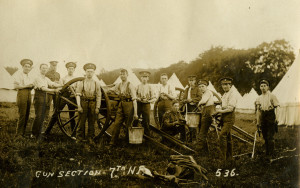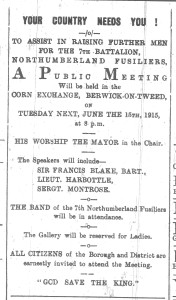BERWICK ADVERTISER, 18 JUNE 1915
NORTHUMBERLAND FUSILIERS PRISONERS
Lady Allendale has received numerous postcards and letters from prisoners interned in Germany, acknowledging parcels sent to them, for which they are most grateful.
One prisoner, writing from Munster, Westphalia, asks for cocoa, sugar, milk, Golden Syrup, Hovis bread, Woodbines, and soap. He says he is only allowed to write two letters a month, so, if this regulation applies to other prisoners, this will account for parcels not being acknowledged regularly.
Lady Allendale understands that at some of the prisons luxuries are not allowed. Therefore, it is advisable only to send such articles of food as bread (brown is best), biscuits, butter, dripping, cocoa, and milk. Anything in the way of luxuries, such as sweets, chocolate, and cakes, are liable to be confiscated.

WOOLER
FOR WOUNDED SOLDIERS: On Sunday afternoon last a united missionary and egg service was held in the Archbold Hall at which there was a good attendance. The Rev. H. Proctor gave an interesting address on mission work in West Africa where he had laboured for some years. All were invited to bring fresh eggs to be sent to the British Red Cross Society for our wounded soldiers and sailors. A collection was also taken in aid of missionary work. The Rev. N. Reid was chairman. At the united service on Sunday in the Archbold Hall, nearly 500 eggs were collected for the wounded soldiers and sailors, and over £3 was taken for the Missionary cause.
BERWICK PUBLIC BOWLING GREEN OPENED
A Splendid Acquisition to the Town
The outcome of the enterprise and labour of a number of the working men in Berwick was witnessed at the Old Bowling Green, Ravesdowne, on Monday evening, when the Mayor (Mr Thomas Wilson) opened the Berwick Public Bowling Green. The mayor was accompanied by the Sheriff (Mr E. W. Stiles), Mr D.H.W. Askew, Castle Hills, Mr H. G. McCreath, Mr J. Elder, Dr C. L. Fraser, Rev. R. C. Inglis and the Secretary of the Club, Mr A. Carstairs. There was a large attendance to witness the opening ceremony.
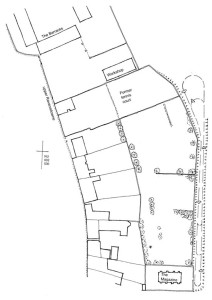
The proposal to have a public Bowling Green in Berwick has been afoot for some time and to expedite the matter a public meeting was called in the Town Hall where it was decided to canvas the town for subscriptions. A good sum of money was obtained but not of a sufficient amount to enable a green to be laid out, for the outbreak of war in a great measure stopped the flow of subscriptions. A splendid opportunity was afforded the Committee when the old bowling green behind the barracks was advertised to be let, and the Committee have entered into a five years lease. This green was where the Berwick Bowling Club first started and it was vacant for some time after that club laid out their green at the Stanks. Later it was occupied for bowls by the officers of the King’s Own Scottish Borderers, but latterly the ground has been utilised for playing of tennis. The turf is in a good state of preservation, and with a little care and attention the surface will soon be made quite suitable for playing. Its condition on Monday evening was excellent considering the short time spent in improving it.
THE ORIGIN OF THE MOVEMENT
Mr Jos. Seals, in calling upon the Mayor to declare the green open, said: – The origin of this movement took place some few months ago. Berwick Town Council was approached with a view to providing as they do in other towns, a public bowling green to be within the financial reach of the working classes. Owing to their having so much in hand they found it impossible to carry out what was required. The Mayor kindly suggested that a public meeting be called, and from that meeting we have this green. We commenced to canvas the town for subscriptions to assist financially and as far as we went the town responded right nobly, but owing to the war we had necessity to cease asking for subscriptions owing to the very large number of necessities that had arisen from the war. The matter then lay for some time until it was seen in the papers that the green was to be let. A committee meeting was called and without hesitation it was decoded to take the green and bring the matter to a successful issue to the best of our ability. We still have a need for more financial support but we have sufficient confidence in the public spirit of the Borough to know that that need will be supplied. We propose in some way to make arrangements for allowing the different bodies of soldiers in the town to play on the green. We should like to let them play free but as that would be killing the goose which lays the golden egg, we will meet them in the best way we can. I have great pleasure in calling upon the Mayor to open this green, and I may add that we have had assistance from the beginning and our success in a very large measure is due to him. (Applause)
THE GREEN OPENED
The Mayor said: let me congratulate this Committee of Berwick Public Green for having done such a great work as this. I have much pleasure in declaring the green open and I hope it will be taken advantage of by the working class. (Loud applause)
The Mayor, thereafter played the first bowl and was followed by the Sheriff, Mr Askew, and Mr. McCreath.
Play was free to visitors for the evening and a most enjoyable game was played.
FUNDS FOR THE QUEEN’S NURSES
SOLDIERS AND CIVILIANS HELP
Royal Scots…………………..1 Berwick Rovers…………………..0
Without doubt a larger crowd has never gathered at the Stanks, Berwick, than that which viewed the match on Thursday evening between the 2/10th Royal Scots, and Berwick Rovers, at which a collection was taken in aid of the funds of the Berwick Queen’s Nurses. By kind permission of Colonel Peterkin, the Royal Scots Piper Band paraded the principal street before the match, and drew large
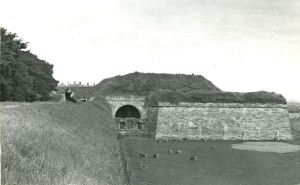
crowds to the venue of play. Collectors were busy amongst the crowd during the match, and the excellent sum of £8 10s was realised. The arrangements for the match were in the hands of Mr. A. A. Crisp, High Street, Berwick. The teams chosen were: Royal Scots-Corpl. Hill ( Queensferry St Andrew’s); Lance Corpl. Hay (Wemyss Athletic) and Pte.Trupe ( Juvenile); Corpl. Anderson ( Juvenile), Pte.Valentine ( Bathgate Primrose), and Pte.Preston ( Bathgate), Sergt. Brown (Armadale Rangers), Corpl. Jameison (Vale of Grange), Pte. McIver (Juvenile), and Pte. Middleton (Linlithgow Rose.) Berwick Rovers- W. Ferguson; R.T. Tait and E.N.Fenby; D.Redfearn, H. Burgon, J.Paul; J. Weatherburn, C. Barth, A. Weatherburn, G. Mofatt, and J. Scobie.


